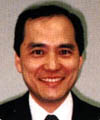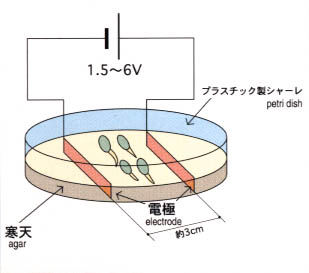| Principal Investigator |
: |
 |
| Hideo Ishikawa, Ph.D. (Ohio State University) |
|
| Objective |
: |
Plant roots respond to gravity and also to applied electric fields.
This experiment in the zero-gravity will allow an examination of the response
of roots to applied electric fields in the absence of a competing gravity
response.
|
| Experiment outline |
: |
Electric fields are applied under the zero-gravity to
roots of young seedlings, and the root growth patterns are recorded continuously
by a video camera.
Seedlings of mung beans, maize, and different strains of Arabidopsis (both
wild type and mutants of gravity responses) are buried within agarose-filled
Petri dishes. The seedlings are launched into the space in a refrigerator
to retard their growth prior to the experiment.
After the seedlings return to room temperature and fully recover with regard
to growth rate, an electric field of about 2 V/cm (maximum) is applied.
The response of the roots is continuously photographed by using a camcorder.
In related experiments, the response of roots to light applied from one
side will be examined.
|
 |
| Maize roots are buried within low conductivity agarose and exposed
to electric fields in the absence of competing gravity. The root growth
will be recorded continuously by a video camera. |
|
| Expected effects |
: |
We expect to observe bending of roots in response to applied electric
fields or unilateral light. Due to the constant presence, on Earth, of
gravitational stimulation, the true growth response of roots to stimulation
by other environmental factors such as electrical fields, light, and mechanical
pressure is usually impossible to observe. Because it is known that subtle
electrical potentials across plant cell membranes play a role in controlling
plant growth, this space experiment should provide important new information
on the relationship between natural electrical phenomena at the cellular
level and the growth performance of plants. This experiment represents
the first study of electrical regulation of plant growth in the absence
of a competing gravity signal.
If the activation of a specific zone of young cells identified previously
is confirmed by this experiment, this will bring us closer to the possibility
of enhancing growth and of improving plant productivity in the future.
|
|
